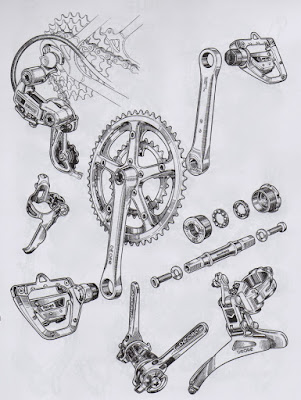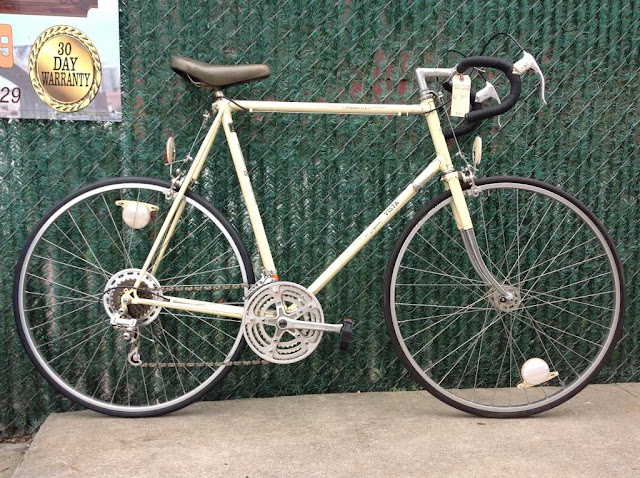It's been a while since I've been to the Dutch or Danish capital, but from what I hear, cycling is still as prevalent a mode of transportation as it was years ago.
What's also striking is the fact that in those cities, no matter what a person's occupation or income, he or she is likely to be riding a bike very similar to whatever someone else might be pedaling to a job, a store or a friend's house. Some might have more elegant paint jobs or a few more creature-comfort accessories, but the basic bike doesn't vary so much. By now, most Americans have seen at least an image of the prototypical Dutch (or Dutch-style) city bike. On it, weight is seemingly no object: Carbon steel bikes with internally-geared hubs are fitted with racks, fenders and other accessories made of the same material. And, of course, they have full chain cases and the women's bikes often have dress guards. Convenience for someone who thinks of him or her self, not as a cyclist, but as a waiter, bookkeeper, technician, accountant, artist, writer or any other kind of worker on his or her way to a job on his or her bicycle. Or, he or she is a shopper, or a grandparent en route to see the grandkids, or can have any number of other identites--and he or she is using a bike as a vehicle (in the original sense of the word) to fulfill tasks, wants, needs, or pleasures.
What I have described is true, if to a lesser degree, in other European cities. And they have their own variations on the "city bike," which have evolved out of decades or even a century or more of cycling as a part of daily life. A French city bike, as an example, is likely to be a bit lighter than a Dutch bike, and is as likely as not to have derailleur gears rather than an internally-geared hub. This has to do with the fact that most French cities are at least a bit hillier than Amsterdam or Copenhagen. (Then again, most cities are.) Plus, even though Paris, Lyon, Toulouse and Bordeaux are relatively compact, given their populations, they are still a bit more spread out than Amsterdam or Copenhagen.
Even so, they are not as hilly as many cities in the Americas. (Lyon is an exception; even Toulouse, which is in the foothills of the Pyrenees, is relatively flat.) And their ideas about how to ride to work are different from those Americans who ride their bikes to their jobs.
Plus...Here's something I've experienced first-hand: Their streets are, for the most part, better-maintained than those in American cities, or at least the ones in New York. There, bikes "age" and get "weathered;" here, a bike that's ridden and parked on the streets every day gets beat up. And, finally, it seems that there's more bike theft here than in European cities.
So, while shops here have begun to carry bikes that are meant to be utilitarian commuters (like the Pashleys and Abicis), I don't see that they are becoming "consensus" commuters. I've seen a couple of those bikes hee, and a few more that strive to emulate (or cynically copy the most obvious features of ) them, like the Breezers and the city commuters marketed by Specialized, Giant and Trek. But I think that if they are going to become standard commuters' fare in this city, that day will be some time in coming.
New York is still a city in which bikes become, rather than are made to be, commuters or utility vehicles. I realized this when I passed by the Bel Aire Diner, which is three blocks from my apartment. I often eat there, and I pass it (or at least see it) nearly every day. There is always a gaggle of bicycles outside
Yes, those really are delivery bikes: The diner does a lot of deliveries and employs more delivery men (Yes, they're all male.) than the average restaurant.
They're like a lot of bikes that are ridden to jobs, schools, appointments and stores: Far from their original owners and purposes. About ten or fifteen years ago, most bikes parked on streets were bike-boom-era ten-speeds (Some of which had been turned, whether or not by design, into single-speeds.); some were English three-speeds or imitations thereof and some others were lower-end, first-generation (early-to-mid '80's) mountain bikes.
These days, those bikes, like the ones parked by the diner, are likely to be mountain bikes from the early-to-mid '90's or thereabouts. There are a few road machines, and still a few "classic" bikes from the '70's. Even many of the so-called "hipster fixies" started their lives as multigeared touring or racing bikes from that era.
But, even with all of the students who ride to Pratt or SVA on "hipster fixies," or all the mountain-bikes-turned-delivery-hacks, there is still no signature commuter or utility bike for this city as there is for its European counterparts. And, somehow, I don't think there will be, at least not for some time.




































